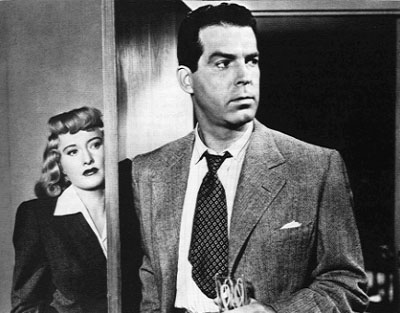Neff works for the ill-named Pacific All-Risk Insurance Company, and his grim escapades with the icy Phyllis Dietrichson (Barbara Stanwyck) as they plot the murder of her husband are followed by the obsessive, relentless Keyes (Edward G. Robinson). For Neff, the long hot Southern California nights quickly frame a tortured psychic journey. As he confesses to Keyes:
Nothing had slipped, nothing had been overlooked. There was nothing to give us away. And yet, as I was walking down the street to the drugstore, suddenly it came over me that everything would go wrong. It sounds crazy, Keyes, but it's true, so help me. I couldn't hear my own footsteps. It was the walk of a dead man. That was the longest night I ever lived through...
Double Indemnity had many ancestors, including the silent German Expressionist cinema Wilder had worked in during the 1920's, but between them, Wilder and Chandler helped to invent the film noir genre.
The novel Double Indemnity had been written by another master of the hardboiled novel, James M. Cain, and Paramount producer Joseph Sistrom guessed that Chandler, who had written such Philip Marlowe classics as The Big Sleep and Farewell, My Lovely, knew the turf. Chandler had never worked in film before, and his odd combination of timorousness and brazenness initially drove the cynical but professional Wilder crazy. Wilder admired the British-born Chandler's novels for their corrosive images of Los Angeles of the 1930's; only painter David Hockney, another Englishman, said Wilder many years later, has been as adept as Chandler at capturing Los Angeles. But when Chandler began their collaboration by providing a script loaded with screen directions and camera angles, Wilder shuddered, and began a stormy lecture on 'how to write for the movies.' Chandler quickly turned "bad-tempered -- kind of acid, sour and grouchy," said Wilder, but the novelist adapted himself to the rigors of collaborative writing with a grace that startled Wilder, and the two settled down in their cubbyhole on the fourth floor of the Paramount writers' building. "Yes, we worked well," said Wilder, speaking of their methods on Double Indemnity: "We would discuss a situation. Once we had the broad outline, we added to and changed the original story and arrived at certain points or orientation that we needed. Then we would start scene by scene, and we started with dialogue, and then with transitions. And he was very good at that, just very, very good." Chandler proved adept at screenwriting. His scripts for the film noir thrillers The Blue Dahlia and Alfred Hitchcock's Strangers On A Train are among his best work in any medium, and James M. Cain felt Chandler had done a better job on the film of Double Indemnity than Cain had done on the novel. Indeed, Chandler found it difficult to return to novel writing. His last novels feel unfinished, inchoate; Wilder believes that the intensely insecure and lonely Chandler had come to depend upon the comradeship and reassurance of studio screenwriting.
The streets of Los Angeles are busier and deadlier than they were in Chandler's heyday. Yet Chandler's disquieting, existential take on the City of Angels transcends fashions in both transportation and crime. Those mean streets remain mean, and mementos of Double Indemnity can still be seen all over the city. The Hollywood Bowl where Walter and Lola Dietrichson meet; Walter's apartment at the Chateau Marmont; the Glendale train station where the "perfect crime" begins... And the "death house" of Double Indemnity, where Phyllis and Walter meet, plot murder, and where their strange love finally reaches its apocalypse, still stands, secluded and quiet, high in the Hollywood Hills, at 6301 Quebec Street, in Los Angeles. Exteriors were shot there, and sets were modeled after the inside of the house. The house seems to rear up in the summer twilight, remembering the night fifty years ago when a cruel woman brought her husband out to a big LaSalle sedan idling in the garage, with a killer in the back seat. The house's silent, stuccoed cloisters look gloomily down on Quebec Street, while Walter Neff's disembodied footfalls echo off the asphalt.


